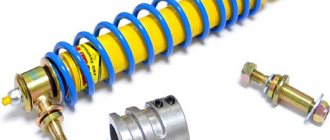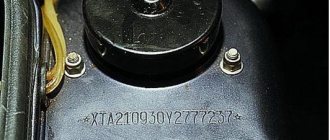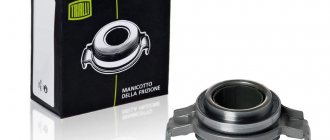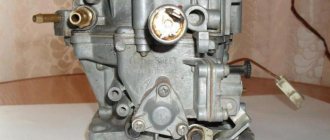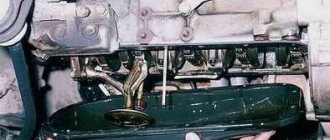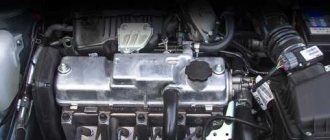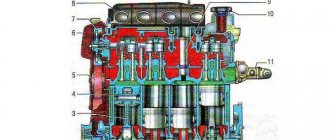The engine is the iron heart of every vehicle. If any of its components fails, there is a high probability of complete failure of the entire unit.
Especially when we are talking about such severe damage, such as deformation of the cylinder head or block. If you do not eliminate them in a timely manner, you will have to do a major overhaul of the engine.
Note that cracks in these components are among the most complex faults. They usually occur after a traffic accident with a high level of wear of parts or manufacturing defects.
Causes and symptoms of malfunction
Below are the “symptoms” that indicate the presence of a crack in the head or block.
Important! These same signs can indicate other malfunctions! Therefore, one should not make hasty conclusions.
- The engine overheats, antifreeze or other coolant leaks. To make sure that the problem is not a crack, check how well the cylinder head bolts are tightened, as well as the tightness of the system.
- The temperature control system is not working correctly. Due to overheating, the cylinder head is deformed.
- Failure of the expansion tank plug, which causes the formation of air masses.
- During the summer period of the year, the temperature sensor needle jumps sharply in different directions.
Symptoms also include “tripping,” which is especially noticeable when moving downhill.
Important! To verify the presence of cracks, you need to unscrew the spark plug. Afterwards, in the literal sense of the word, taste the liquid from the candle. If it turns out to be sweet, it means that coolant is entering the oil through a crack. In this case, try adding oil to the system and starting the car (without closing the expansion tank cap). If it boils immediately, it means that a microcrack is absolutely present in the cylinder head.
Note that cracks often occur near the bushing (guide or intake valve). In this case, you will have to completely replace the head.
Another sign is the loss of gases. To find out that this is the reason, we recommend putting a rubber glove on the expansion tank. If it inflates over time, there is a problem.
A microcrack in the engine block is no longer a problem
The engine is the iron heart of every vehicle. If any of its components fails, there is a high probability of complete failure of the entire unit.
Especially when we are talking about such severe damage, such as deformation of the cylinder head or block. If you do not eliminate them in a timely manner, you will have to do a major overhaul of the engine.
Note that cracks in these components are among the most complex faults. They usually occur after a traffic accident with a high level of wear of parts or manufacturing defects.
Water test
This method is similar to the previous one. The whole difference between them is that you don’t need to lower the head with water, but quite the opposite - you need to pour it into the head:
- Check all the holes for leaks.
- Then pour the channel into the water.
- Next, using a pump, pump air into the channel.
- Leave the part to be treated for several hours. If you notice that the water has gone, it means there is a problem with the head and it needs to be changed or, at best, repaired (which will be cheaper, but... will not guarantee the longevity of this component).
Symptoms of a crack in the cylinder block and cylinder head
There are several signs that, if detected, should sound the alarm and send the engine for diagnostics. They may indicate both the formation of cracks in the engine and other malfunctions. Most often, cracks in the cylinder block and cylinder head are indicated by:
- Regular engine overheating. If, due to a crack, the system is no longer sealed, this will lead to coolant leakage and constant overheating of the engine. This problem can also occur due to burnout or other defects in the cylinder block gasket;
- Problems with the operation of the temperature control device (thermocouple). This is fraught with severe overheating of the engine and its deformation;
- The expansion tank does not hold pressure and air pockets form;
- Incorrect temperature sensor readings. If the temperature sensor needle changes chaotically, either up or down, this may indicate sharp changes in the temperature of the engine itself during operation;
- Engine vibrations. One of the most obvious signs of cracks in the cylinder block. If the engine vibrates or shakes excessively, especially when driving uphill, this may indicate the presence of microcracks in the engine block.
Pressure diagnostics
This technique is performed in several ways: immersion in water or without it. Read below on how to perform these operations.
Immersion in water:
- Initially, close all channels of the spare part that may be adversely affected by water.
- After this, place the part in a container filled with water over 40 degrees Celsius.
- Then use compressed air (there is a crack in the places where bubbles appear).
The procedure without “immersion” is performed as follows:
- As in the previous case, make sure that all GBU channels are closed.
- Pour the soap solution onto the lid.
- Supply air masses into the circuit of the “sick” part. If there is a defect, soap masses form at this place.
Let's sum it up
Taking into account the above, the cylinder block liner is a part of the CPG, which is largely exposed to high temperatures, vibrations and detonation loads. Therefore, the risk of various types of defects, which can lead to expensive engine repairs, is significantly increased.
In such a situation, it is optimal to use the help of qualified specialists and carry out troubleshooting, since non-professional repair or replacement of cylinder block liners without using technology can significantly affect the service life and stability of the internal combustion engine.
Why is a liner installed in the cylinder block? Advantages and disadvantages of sleeved motors, aluminum alloy blocks, features, repairs.
Repairing a cast iron or aluminum engine cylinder block using a liner. Types of sleeves and how the sleeves are inserted into the block. Tips and tricks.
Why and when does the cylinder head need to be ground? How to check the mating plane of the block head with your own hands. Milling and grinding of cylinder head.
What is engine troubleshooting and in what cases is it necessary to troubleshoot the motor. Features of power unit troubleshooting, recommendations.
What does it mean to overhaul a car engine, what work is performed. What determines the engine life before overhaul and how to increase it. Useful tips.
How to determine when an engine needs a major overhaul: engine life, the main signs of an imminent overhaul. How to repair an internal combustion engine, tips
Electric welding
First, you need to drill out the “sore” areas with a tool so that they stop increasing in volume. Afterwards they need to be sanded.
So, at the beginning of work, we heat the block to 650 degrees Celsius, after which, using a special rod, we make a seam. To prevent its oxidation, you need to use borax.
As a result, after finishing the work, there should be an even layer on the surface (the protrusion of which is no more than two mm.). The next stage is the heating cabinet (cooling in it).
Repairing cracks using welding
It should be noted that splits must be eliminated in strict accordance with all recommendations. Residual mechanical stresses in the weld area can lead to damage to its integrity and the need for repeated repairs.
A cast iron block is repaired by drilling out the ends of the crack and then grinding the entire length of the split at a 90-degree angle. Drilling is necessary to prevent further spread. As for welding, at the initial stage the cylinder block is heated to 650 degrees Celsius. After this, a continuous seam is applied using a cast iron-copper rod and flux. The final stage is the gradual cooling of the part, which requires a special heating cabinet.
In order not to warm up the block, you can use electric welding and copper electrodes in a tin wrapper. Upon completion, the surface of the resulting seam is degreased with acetone and an additional layer of epoxy paste is applied with a special spatula. Epoxy hardens within 24 hours at room temperature and about 2 hours when heated to 100 degrees Celsius. The final stage will be sanding the treated seam.
Welding the patch
To perform this operation, you need to select a piece of metal that matches the size of the crack. Next you need to weld the selected material. The next stage is grinding and coating the treated area with a special paste.
Well, now you know what a cracked cylinder head is, as well as how to deal with this problem. In any case, it is better to prevent a breakdown than to fight it.
Crack in the cylinder block
Deformations of key engine elements, such as the cylinder block and cylinder head, are serious malfunctions that, if not corrected in a timely manner, can lead to the need for major engine repairs. The formation of cracks in the engine block and cylinder head is one of the most difficult breakdowns in a car. Cracks can occur due to impact (for example, during an accident), due to high wear or manufacturing defects. In this article, we will look at how to determine that the engine cylinder block or cylinder head is cracked, and what can be done about it.
Options for diagnosing the problem
To make repairs and eliminate microcracks, you need to be completely sure that they exist. Let's look at several diagnostic options that can be done at home.
Magnetic powder diagnostics
The method is the fastest type of repair in detecting microcracks. It consists of the following: install magnets on all sides of the cylinder head. Sprinkle the cylinder head with metal shavings on top; they will begin to move towards the magnets, remaining on cracks and dents. So, it won’t be difficult to notice cracks.
Metal shavings for diagnostics
Diagnostics using liquid
To check the cylinder head for defects using this method, you will need a special coloring liquid.
- Rinse the surface of the head thoroughly; to do this, use acetone, kerosene or another type of solvent.
- Apply a special liquid to the cleaned surface and wait a few minutes.
- Then use a clean cloth to rinse off any remaining liquid. If there are defects on the cylinder head, they will be visible to the naked eye.
Pressure test
The method can be implemented in several ways: with and without immersing the cylinder head under water. Perform an immersion test:
- If you decide to carry out diagnostics by immersing the cylinder head in water, then you need to tightly close all the circuit channels of the upper part of the unit, then place it in a container and pour hot water into it.
- Then apply compressed air to the cylinder head circuit and where bubbles appear, there will be microcracks.
Pressure diagnostic equipment
The method without immersing the block in water is used to search for holes in punctured tires:
- It is necessary to tightly close all channels of the cylinder head circuit.
- After this, a soap solution should be poured onto the surface of the head cover.
- Air must be supplied to the circuit. Where a defect is found on the surface of the head, soap bubbles will appear.
Water test
The method is no different from the previous one. The only difference is that the head does not need to be immersed in water, but water should be poured into it:
- Close all openings hermetically.
- Pour more water into the channel.
- Then, using a regular pump, you need to pump air into the channel to make the pressure at least 0.7 MPa.
- Afterwards, you need to let the head stand for several hours. If the water is gone, this indicates a defect in the head. This means that repairs cannot be avoided.
Argon surface welding
How to detect a crack?
There are several ways to check the cylinder block or cylinder head for a crack.
- Visual inspection. The method is mainly suitable for searching for external cracks and significant leaks in the liner. Ineffective when searching for microcracks and hidden defects.
- Hydraulic crimping method. Most often used for troubleshooting cylinder heads and cylinder blocks, as it is ideal for parts of complex shape with internal cavities and channels. During testing, all external openings of the block head/BC are hermetically sealed. Through a special adapter, compressed air is supplied to one of the water-filled zones at a pressure of 0.6-0.8 MPa. Often, signs of a microcrack begin to appear only when the engine is warm. To increase accuracy, hydraulic tests are carried out in a bath with water heated to 90-95ºС. In the event of a crack, fluid from one channel will penetrate into the adjacent zone. When crimping liners, the piston should be set at bottom dead center (BDC). Through a special mandrel, compressed air is supplied directly to the cylinders. In this case, adjacent channels are filled with water and in case of hidden damage, compressed air will bubble out through the water-filled channels.
- Color flaw detection method. A colored penetrating pigment is applied to the element under study. The part is washed and then treated with a contrast developing solution. The outline of the crack is revealed by the color of the pigment against the general background of the solution. Color flaw detection allows you to detect microcracks up to 0.001 mm wide and is suitable for searching for defects in parts made of any material.
- Magnetic flaw detection (available for cast iron and steel parts). The part is magnetized and then sprinkled with ferromagnetic powder or suspension. In the microcrack zone, the magnetic field is non-uniform, which is why the contour of the defect appears as an accumulation of ferromagnetic material.



